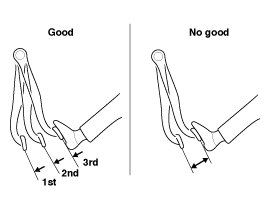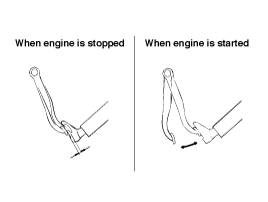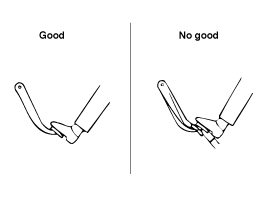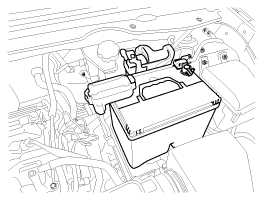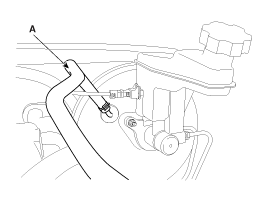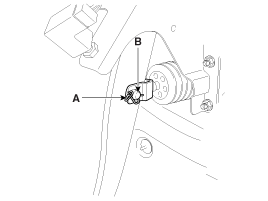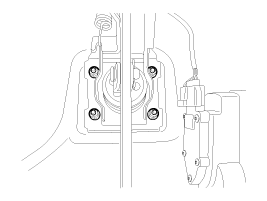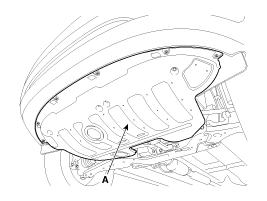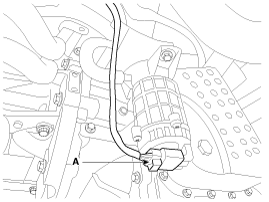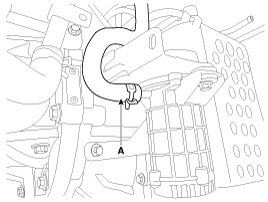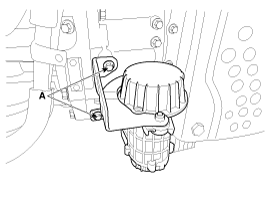 Kia Sportage: Brake Booster: Repair procedures
Kia Sportage: Brake Booster: Repair procedures
Third generation SL (2010ŌĆō2016) / Kia Sportage SL Service & Repair Manual / Brake System / Brake System / Brake Booster: Repair procedures
| Brake Booster Operating Test |
For simple checking of the brake booster operation, carry out the following tests.
| 1. |
Run the engine for one or two minutes, and then stop it. If
the pedal depresses fully the first time but gradually becomes higher
when depressed succeeding times, the booster is operating properly, if
the pedal height remains unchanged, the booster is inoperative.
|
| 2. |
With the engine stopped, step on the brake pedal several times.
Then step on the brake pedal and start the engine. If the
pedal moves downward slightly, the booster is in good condition. If
there is no change, the booster is inoperative.
|
| 3. |
With the engine running, step on the brake pedal and then
stop the engine.Hold the pedal depressed for 30 seconds. If the pedal
height does not change, the booster is in good condition, if the pedal
rises, the booster is inoperative.
If the above three tests are okay, the booster performance can be determined as good.
Even if one of the above three tests is not okay, check the check valve, vacuum hose and booster for malfunction.
|
| Removal |
Brake Booster
| 1. |
Turn ignition switch OFF and disconnect the negative (-) battery cable. |
| 2. |
Disconnect the battery terminal and then remove the battery.
|
| 3. |
Disconnect the ECM connector and then ECM and battery tray. |
| 4. |
Disconnect the vacuum hose (A) from the brake booster.
|
| 5. |
Remove the master cylinder. (Refer to Master cylinder) |
| 6. |
Remove the snap pin (A) and clevis pin (B).
|
| 7. |
Remove the mounting nuts.
|
| 8. |
Remove the brake booster. |
Vacuum Pump
| 1. |
Turn ignition switch OFF. |
| 2. |
Remove the under covers (A).
|
| 3. |
Disconnect the vacuum pump connector (A).
|
| 4. |
Disconnect the vacuum hose (A).
|
| 5. |
Loosen the vacuum pump bracket bolts (A), and then remove vacuum pump and bracket.
|
| 6. |
Remove the 2 bolts, and then remove the bracket from vacuum pump. |
| Inspection |
| 1. |
Inspect the check valve in the vacuum hose, intensifier and the connecting section.
|
| 2. |
Check the boot for damage.
|
Vacuum Pump
| 1. |
Check the brake warning lamp in the IGN ON position.
|
| 2. |
Check that the brake warning lamp is ON after the release the parking brake with a sufficient brake fluid level.
If the brake warning lamp is ON, check the below points.
|
| Installation |
Brake Booster
| 1. |
Installation is the reverse of removal.
|
| 2. |
Adjust the brake pedal height and free play.
(Refer to Brake pedal height and free play adjustment) |
| 3. |
After installing, bleed the brake system. (Refer to Brake system bleeding)
|
Vacuum Pump
| 1. |
Installation is the reverse of removal. |
| 2. |
Tighten the vacuum pump mounting bolts to the specified torque. |
 Brake Booster: Components and Components Location
Brake Booster: Components and Components Location
Components (1)
1. Brake booster2. Master cylinder assembly3. O-ring
Components (2)
1. Vacuum pump2. Bracket
...
 Master Cylinder: Components and Components Location
Master Cylinder: Components and Components Location
Components
1. Reservoir cap2. Reservoir3. Grommet4. Master cylinder
...
Other Information:
Air conditioning system
We recommend that you contact an authorized Kia dealer for more details. ...
ETC (Electronic Throttle Control) System: Troubleshooting
Fail-Safe Mode
ItemFail-SafeETC MotorThrottle valve stuck at 5┬░TPSTPS 1 faultECM looks at TPS2TPS 2 faultECM looks at TPS1TPS 1,2 faultThrottle valve stuck at 5┬░APSAPS 1 faultECM looks at APS 2 ...
Categories
- Home
- Kia Sportage QL (2015-2019) Owners Manual
- Kia Sportage QL (2015-2019) Service Manual
- Kia Sportage SL 2010-2016 Owners Manual
- Kia Sportage SL 2010-2016 Service Manual
Copyright ® www.kispmanual.com 2014-2026

